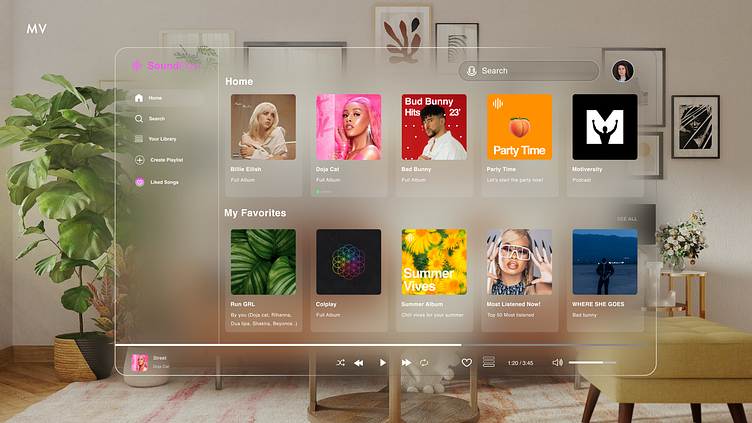VR Platform view | UX Design | SoundFlow 23'
Sound Flow - Revolutionizing VR with Seamless User Experience 👓
Introduction - Welcome to the presentation on Sound Flow - a groundbreaking VR platform designed to enhance your auditory and visual experience like never before. - I'm Mel, a passionate and innovative product designer. Today, I'm excited to showcase my UX design for Sound Flow, which aims to redefine the way we interact with virtual reality.
Understanding the Problem - Virtual Reality (VR) has made significant strides in recent years, but there are still challenges to overcome, especially in terms of user experience. - The Problem: Current VR platforms often suffer from clunky interfaces, disorienting navigation, and inadequate audio immersion, leading to a less immersive experience.
Defining the Goal - Our goal with Sound Flow is to create an intuitive, seamless, and immersive VR platform that prioritizes the user's sensory experience. - Primary Objectives: - Intuitive navigation: Simplify the way users interact with the VR environment. - Audio immersion: Enhance the sound experience to complement the visual elements. - Visual aesthetics: Design an interface that is visually appealing and easy on the eyes.
User-Centered Design Process - To achieve our goals, we followed a user-centered design process: 1. Research: Conducted extensive user research to understand pain points and expectations. 2. Ideation: Brainstormed and prototyped various design concepts. 3. Iteration: Gathered user feedback and iterated on the designs to refine the experience. 4. Testing: Conducted usability tests to validate the final design.
Design Solutions - Navigation: Implemented an innovative 3D spatial navigation system that allows users to move intuitively within the virtual environment. Users can effortlessly reach out and interact with elements in the VR space. - Audio Immersion: Employed spatial audio technology, providing users with a realistic and 360-degree auditory experience, adding a new dimension to the virtual world. - Visual Aesthetics: Opted for a minimalist and clean design, reducing distractions and providing a visually engaging experience.
Intuitive Interaction - Let's take a closer look at how Sound Flow offers an intuitive interaction experience: - Demonstration video of users navigating and interacting with the VR environment seamlessly.
Spatial Audio Experience - Sound Flow's spatial audio technology allows users to perceive sound as if it is coming from specific locations in the virtual space. - Benefits: - Enhanced immersion and presence. - Better orientation and spatial awareness. - Realistic and lifelike experiences.
Visual Aesthetics - Sound Flow's visual aesthetics contribute to a more enjoyable and comfortable VR experience: - High contrast visuals to reduce eye strain. - Minimalist design for a clutter-free interface. - Customizable elements for personalization.
User Feedback - Throughout the design process, we collected user feedback and made iterative improvements. - Testimonials from users who experienced Sound Flow: - Positive feedback on the intuitive navigation. - Appreciation for the realistic audio experience. - Compliments on the visually appealing interface.
Conclusion - Sound Flow represents the culmination of extensive research, iterative design, and user feedback, resulting in a VR platform that sets new standards for user experience. - As a product designer, I am immensely proud to have contributed to this project and am excited about the future of VR.
Thank you for your time. I'm now open to questions and feedback ❤️
Download for free here! 🪄😊 💝
